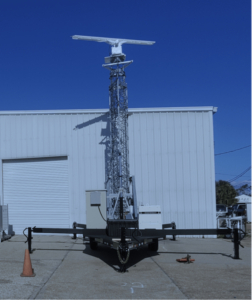
Continue reading below, or listen:
BVLOS flight is critical to scaling industrial drone operations. While a BVLOS rule has yet to be published, the FAA has indicated that they are committed to issuing BVLOS waivers that will help to inform future rulemaking. Early waivers allowed drone flight beyond the visual line of sight of the pilot, but required a daisy chain of visual observers along the flight path, limiting the feasibility of long distance operations. Now, the FAA is expanding permissions to allow flight without human visual observers with appropriate systems in place to detect air traffic and ensure safety.
How can operators ensure that they avoid collisions with both cooperative traffic – aircraft with ADS-B or other means of notification – and noncooperative traffic that is not broadcasting and may not show up on existing systems?
Radar is a proven method of monitoring airspace for any aircraft, and DeTect’s HARRIER mobile radar tower is a flexible solution for BVLOS drone operations. The Texas A&M Corpus Christi Lone Star Center of Excellence in UAS (TAMUCC LS) has contracted for an initial six-month rental of a mobile HARRIER S200d BVLOS unit. The trailered system is fully self- contained with an extendable 55 ft radar tower and on-board power and computer systems. The units will be used to support beyond visual line-of- sight drone operations at the TAMUCC LS UAS range and includes a purchase option.
DeTect’s HARRIER BVLOS was first deployed in 2008 and currently is in wide use by UAS operators and development ranges in the US and Europe. The system provides long range (20+ miles) airspace monitoring with automatic risk advisories that include both cooperative and non-cooperative air traffic. The HARRIER BVLOS system is designed for simultaneous detection of UAVs, drones and conventional aircraft (ultralights, helicopters, small-to-large aircraft): the Intelligent Sensor technology classifies the target type.
The Texas A&M contract will enable more testing of BVLOS operations – providing the data required to prove the safety case for commercial BVLOS drone flight at scale.
Read more:
- DeTect’s Largest, Longest Range Surveillance Radar: Aircraft Detection for 30 Nautical Miles
- It’s a Bird; It’s a Drone; DeTect Dual Function Radar Tracks Both
- BVLOS Inspections, No Humans Onsite: Percepto Wins FAA Waiver for Operations Within Shielded Airspace
- BVLOS Power Line Inspection, No Visual Observers: What’s Involved in the Pheonix Air Unmanned Waiver
Miriam McNabb is the Editor-in-Chief of DRONELIFE and CEO of JobForDrones, a professional drone services marketplace, and a fascinated observer of the emerging drone industry and the regulatory environment for drones. Miriam has penned over 3,000 articles focused on the commercial drone space and is an international speaker and recognized figure in the industry. Miriam has a degree from the University of Chicago and over 20 years of experience in high tech sales and marketing for new technologies.
For drone industry consulting or writing, Email Miriam.
TWITTER:@spaldingbarker
Subscribe to DroneLife here.